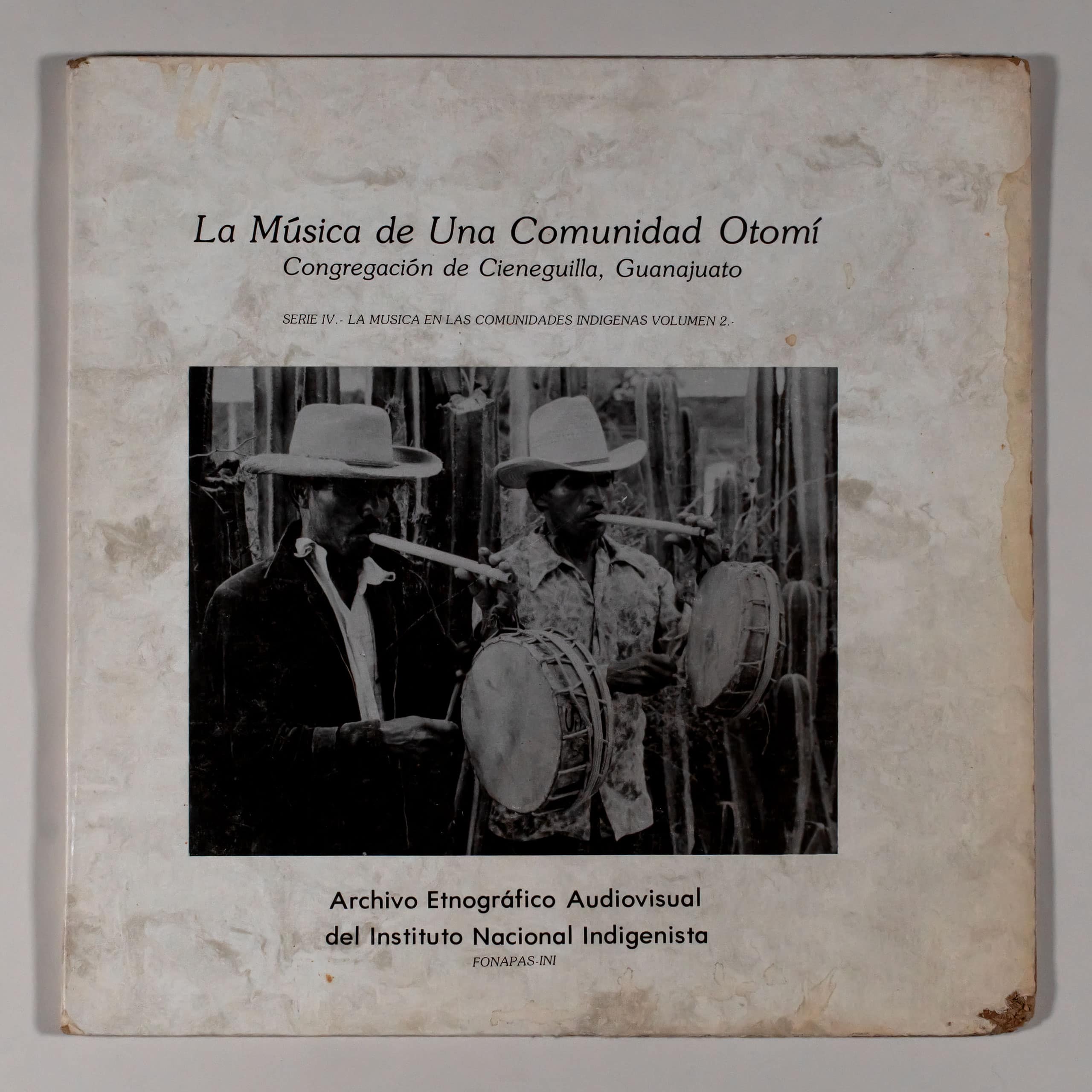
|
Label: Sonido 13 |
Country: France Genre: Microtonal |
Info:
JULIAN CARRILLO, was since the beginning of this century, the most genuine representative of Mexican music. With that character, he participated in numerous International Congresses, alongside Camilo Saint Saens, Romain Rolland and that musician to whose memory he consecrates the deepest admiration: Claude Debussy.
Despite his professional activity, Carrillo meditated on the transcendental consequences of a discovery that he had made since 1895, while he was still a student at the Conservatory of Mexico.
Indeed: coming out of an acoustics class, he had tried in vain to get the full range of natural harmonics on his violin; and impatient before the impossibility of achieving it with his fingers, too thick, he used a knife and with the edge of it, he was able to divide the rope hearing extraordinary sounds; and he found that the ear can clearly perceive intervals separated from each other by the distance of up to a sixteenth of a tone.
Later, his studies on acoustics led him to surprising achievements: according to classical acoustics, in the natural scale of harmonics, the fundamental is repeated from octave to octave (the so-called even harmonics) and Carrillo found that this interval (the octave) is just an approximation and that in reality all sounds produced by harmonics are different”.
Farewell to the physical foundations of our major diatonic scale!
It is true that music, since Bach, rests on a mathematical and not a physical basis (the division of the octave into twelve equal intervals) and that the musical instruments called “tempered” do not give, in the sounds they produce, more than one approach.
Julián Carrillo also formulates the bases and principles on which he will later develop a new music: each vibration is a different sound, and for this reason they can be used freely, within the domain of 30,000 vibrations per second that the human perceives. human ear. So why limit the division of the so-called eighth to only twelve? If we want to keep this interval as a point of reference, let’s divide it into as many parts as we think necessary, for example, into the ninety-six intervals that the sixteenths give us.
Julián Carrillo then embarked on a new kind of “lutherie” and made third and sixteenth tone harps. He later had fifteen pianos built (with the same look and keyboard as the classical piano) but producing key to key, 1/4, 1/5, up to 1/15 and 1/16 pitch.
A new problem presents itself to the composer: musical writing.
For sixteenth piano, he needed to find fifteen signs between the intercalation of a tone, from D to Mi, for example.
Carrillo conceives the idea of a universal solfeggio that adapts to any system, whose base can be indistinctly semitones, thirds, fifteenths… and for this extraordinarily simple system, he takes the numbers recommended by J. J. Rousseau, perfecting and generalizing their use. .
By means of a numerical table superimposed at will on the instruments, music can be played and memorized with extraordinary ease. (Annik Simon, who performs the “Prelude to Columbus”, prefers the notation by numbers, to the traditional writing adapted to quarter tones).
Here’s an example:
DO RE MI
0 1 2 3 4 5 6 7 for third tones.
DO RE MI
0 1 2 3 4 5 6 7 8 9 for quarter tones
If we add to this that with this writing up to nine octaves can be indicated with only a fixed line and two dashes, we must recognize the extraordinary effort of simplification and rationalization for the classical writing system that even represents a single sound in twenty-seven ways. different. (Changing the keys and using the flats, sharps, double flats, double sharps…).
However, these reflections, this meditation, these inventions that led Carrillo to forge a totally new musical system and to advocate a more logical graph for the representation of sounds, are nothing more than the preliminary stages of an abundant and amazingly diverse creative work.
Three styles that coincide with three eras can be clearly distinguished.
The works of youth: Julián Carrillo comes to Europe at the dawn of this century. He is already a brilliant violin virtuoso and comes to study composition and conducting in Germany. At that time he writes his First Symphony and the Sextet, works whose roots go deep into German romanticism, especially Brahms, whose amazing technical mastery Carrillo assimilated to perfection.
In a second period, Carrillo writes atonal music, but always faithful to the lyricism and inspiration of his first period.
Finally, (it could be said that Debussy’s encouragement helps him to liberation) he launches himself as a composer towards that unknown world whose shores the young acoustician had reached since 1895… and thus “Prelude to Columbus and “Horizons” are born. The enormous responsibility of discovering a new continent seems at times to frighten the visionary spirit of the musician, but the awareness of the transcendental nature of the world envisioned conceals the simplicity of his message.
It is true that in the quarter tones he feels himself in known seas and his lyricism expands freely; but beyond in the thirds, in the sixteenths, one imagines him scrutinizing the horizon in a pause, in a kind of fleeting anguish, from which violent bursts of glory suddenly arise, from the intoxication of the explorer’s triumph, first to discover unknown landscapes …
Such is the message of Julián Carrillo, Christopher Columbus of Music!
Jean Etienne Marie
Director of sound research at “Radiodiffusion Télévisión Française”.
ANALYSIS OF THE WORKS
Julián Carrillo’s work greatly exceeds what is presented in this collection. Three classical symphonies, three in sixteenth tones, five Symphonic poems, several Masses, a Requiem, three Operas and numerous chamber music compositions, were not taken into account by the author when making these recordings.
The album consists of twelve discs, four Stereo (green label) and eight Monaural (red label).
In the Stereo discs, dedicated to orchestral works, compositions from the most diverse eras (the most recent and the oldest) are presented. In Monaural discs, classical works are grouped, atonal or in quarter tones, according to their duration and responding to the needs of time to form the different faces.
The brief analysis of the works that we present below, follows the numerical order of the discs contained in this album.
Disc I
first face
“PRELUDIO A COLON”
It is the first work written in the new system created by the composer. Dedicated to the great navigator who discovered America, it seeks to describe the impressions of fear, amazement and content joy that are experienced when unveiling the mystery of a new universe.
A sixteenth tone harp, a quarter flute and a string quartet create the sound atmosphere in which the voice unfolds in delicate arabesques written in quarter tones.
The work premiered on February 15, 1925 in Mexico in the first concert in the world with this new music and during which the enormous emotional possibilities of the sixteenth tone harp were discovered.
Months later, several works by Julián Carrillo were performed in New York and Philadelphia, under the direction of Leopoldo Stokowski, with enormous success, among others a Concertino for a small instrumental ensemble accompanied by a symphonic orchestra.
The Prelude to Columbus was conducted personally by the author, in the new UNESCO room in Paris in 1958 before an enthusiastic audience.
“BALBUCEOS” for sixteenth tone piano.
No other name could express better than “Balbuceos” the initial attempt, the first adventure of a composer who tries to penetrate the unknown world of sixteenths of tone.
This work was written at the request of Leopoldo Stokowski for a Contemporary Music Festival held in Houston, United States of America, where it was premiered on March 18, 1960, by the composer’s daughter Dolores Carrillo, the pianist, under the direction of that famous director. orchestral.
Disc I
second face
“HORIZONTES”
Once again, at the request of Leopold Stokowski, this work was written. The eminent conductor conducted it in 1951 – 1952 in Pittsburgh, Washington, Minneapolis and Baltimore and was so successful that it had to be repeated at the request of the public.
It is like a meditation for three solo instruments, violin and cello that play quarter and eighth tones and harp for sixteenths, surrounded by the sound atmosphere created by the orchestra.
In it, the composer tries to evoke the contemplation of a new musical horizon, blurred by the mysterious mist of unknown facts and that developed over time…
The whole work wraps the listener in this impression of mystery and ends in a highly spiritual climate in which the harmonics used insistently are like a symbol. “This music leads to ecstasy,” said an eminence upon hearing it.
Disc II
first face
CONCERT in quarter and eighth tones for cello
This work was premiered in Brussels during the Universal Exhibition in 1958, in a great gala concert dedicated to the compositions of Julián Carrillo and was honored with the presence of Her Majesty Queen Elizabeth of Belgium. The author conducted the orchestra of the Belgian National Radio Institute.
The work is grandiose and demands extraordinary virtuosity from the performer. The use of intervals of fourth and eighth tones makes it necessary to have all the resources of a new technique and harmonics are used to the extreme limit.
Disc II
second face
CONCERTINO for third tone piano
Since 1895, Carrillo discovered the sixteenths of a tone, but as we have already said, he followed his searches, his experiments and his first achievements almost in silence.
This explains why eminent European musicians, ignorant of the Mexican master’s discoveries, thought about the problem of third tones until much later.
That is why Busoni, in the year 1922, wrote shortly before his death: “Sixteen years ago I conceived a possible theoretical system of thirds of tones, but to date I have not been able to decide to proclaim it definitively. The intervals of whole tones , used by Liszt and Debussy, are by way of a hope that one day they will be filled with intervals of third tones not yet existing”.
In 1949, responding to a survey of the “Figaro” Florent Schmidt declared, “that it was time to go in search of the thirds of tones”.
On that same date, J. Carrillo presented in Mexico a special composition for a third tone piano that he had built, the first link in the chain of fifteen metamorphosing planes of which we have already spoken and which gave its inventor the Great Medal Gold at the Universal Exposition in Brussels “for the high cultural value they represent for humanity”.
This first composition later became the central “Time Slow” of this Concertino which was premiered on November 9, 1958 in Brussels.
Claudio Delvincourt (1) upon hearing this Lento, exclaimed: “It seems to me that I am contemplating the horizon of future music.”
—-
(1) Director who was of the National Conservatory of Paris.
Disc III
TRIPLE CONCERT for flute, violin and cello with orchestral accompaniment.
A great work that slides like an exotic and yet familiar river. Julián Carrillo creates in it a very particular climate thanks to the constant use of a new scale: (C, D flat, Mi, Fa, Sol, B flat, C) and the unprecedented combination of timbres, flute, violin and cello that is from great wealth.
This is a complex work; like a great river, we already said; but on its route we find landscapes of the most varied, made of youth and poetry. In it they mix from the elegy to the meditation; from greatness to the most extreme mystical elevation.
The work has a classical cut. It is characterized, however, by its three cadences, one for each soloist, to which is added a true “Triple Chain”.
Disc IV
FIRST SYMPHONY
If our reports are correct, this work is the first classical symphony written by a musician from the new continent. It dates from 1902.
Whoever listens to it today for the first time will be surprised to find it so close to Brahms; but let us reflect: the German master died in 1897 and Carrillo was in 1902 a composer in full youth. Let’s think about the innumerable “debussist” works written, not three or four years after the disappearance of Claudio from France, but twenty or thirty later… and that did not have and do not have the mastery of the young Mexican master. Because, study the score and in it you will find a whole science of counterpoint and a solidity of orchestration that equals that of the model.
The inspiration is so great and such audacity and youth are perceived in it, that it authorizes us to ask, What symphony is this? Brahms’s Fifth, written by a young man, extraordinarily gifted, and later to confirm the promise of his genius.
V-Disk
first and second face
Disc VI
first face
First, second and third “CASI SONATAS” in quarter tones for cello
By this name Carrillo wants to indicate a composition that is not strictly subject to the “Classical Sonata” form and is therefore closer to the “Sonata Almost Fantasy”.
In each of these three works, the composer abandons not only the system of the twelve classic sounds, assuming that he uses quarter tones, but also the principle of rigorous time and measure, leaving the performer the greatest freedom of interpretation, as usually do in the cadences.
In addition, these sonatas represent the highest expression of virtuosity in the cello and the extraordinary use of harmonics should be noted above all.
This virtuosity allows the soloists to show off a transcendental technique and for this reason they will occupy a prominent place in the repertoire of higher studies at the Conservatories.
Disc VI
second face
Disc VII
First, second and third quatrains in quarter tones
These three Quartets are from the same period without this meaning that they describe the same interior landscape.
Julián Carrillo, with extraordinary ease, knows how to escape time and flee from the smallness of the present and consequently reveal very diverse inspirations.
On a purely musical level, they present three main characteristics: the use of quarter tones as real harmonic elements and not as passing notes in hyperchromatism; an extraordinary counterpoint in which each of the four voices has equal importance, and finally, an instrumental virtuosity that represents a progress in the technique of the bowed instruments, as are the “Almost Sonatas” for the cello and the Sonatas for solo violin from this same collection.
Disc VIII
First and Second Sonatas for solo violin
As we have already said, Julián Carrillo arrived in Europe at the beginning of the century as a brilliant violinist. He was violin first in the Leipzig Gewandhaus Symphony Orchestra, conducted by Arthur Nikisch and later obtained great distinctions such as the First Prize unanimously and with distinction in the International Competitions in Ghent, Belgium.
I think it is necessary to remember this background, because writing works for solo violin is not very frequent and for its perfect realization it is necessary to know not only the art of composition, but also to possess the technique of the instrument to the maximum degree.
Until today these conditions had only been met in the admirable Sonatas of Juan Sebastián Bach.
The works that we present here are dedicated to Paganini, the prodigious artist who deserves the gratitude and homage of every violinist for the progress that his compositions represent for the technique of the instrument; but in Carrillo’s Sonatas the transcendence of the technique surpasses that of those famous Studies.
We will also point out the use of harmonics and successions of chromatic fifths and fourths that were unusual until today.
The Paris Conservatory organized a competition for the execution of these works and the “Julián Carrillo Prize” was awarded to the winner.
Disc IX
Sextet for bowed instruments
Of the works presented in this collection, this is the oldest and was premiered in Leipzig in 1901.
Like the First Symphony, we find in it an amalgamation of Latin sensibility with a technique that Brahms could have signed. The work is classical. The thematic unit is treated in it with great delicacy.
Disc X
first face
Second Atonal Quartet, dedicated to Beethoven
During the time that Julián Carrillo was studying in Leipzig, the cult of Beethoven was at a maximum intensity that was never repeated afterwards.
Influenced by this environment of admiration-upon Carrillo’s return to Mexico, he founded an orchestra and a Beethoven quartet. Later, as a violinist he played the Sonatas of the Bonn master on multiple occasions and as director of the Symphony Orchestra of Mexico, he took on the task of presenting a Festival with the Nine Symphonies and the Concerts for both piano and violin. . The Ninth was performed before an audience of fourteen thousand people; and less than five years ago (when Julián Carrillo was already over eighty) he was called once again to direct these works.
The Quartet dedicated to Beethoven, is of a very complicated polyphony and in it procedures of great novelty are used, which nevertheless clearly reveal the feelings that animated the composer when writing it and that he indicates in the different movements: Allegro Appasionato – Slowly – Allegro Jocoso – Allegro Final.
Disc X
End of the second face
“MEDITATION” and “IN SECRET”
These small compositions for bowed instruments were written especially for the Philadelphia Quartet in 1927, as a study for quarter tones, and yet they were premiered in a public concert whose program featured one of Beethoven’s last Quartets.
They have been played numerous times in Paris where they have always been very successful.
Disc XI
Quartet in E Flat
During the International Music Congress in Rome in 1911, Julián Carrillo presented his point of view about the reform of the classical forms of the Quartet, the Sonata, the Symphony and the Concerto with the idea of putting them in tune with the times. .
Search for a maximum of ideological unity while achieving a balanced polyphony in the different tenses.
Such was his thesis perfectly illustrated in this work in which the initial theme is developed in the four beats of the quartet according to the principles of the strictest and most ingenious counterpoint, which produces a magnificent result.
Disc XII
ATONAL QUARTET dedicated to Debussy
We have already mentioned the deep admiration that J. Carrillo professes for the great French composer, Debussy, whom he met in Rome in 1911 during the Music Congress in which Carrillo was elected President.
Recently, Carrillo presented in Mexico the initiative to erect a monument to Claudio Aquiles in that city. How many French cities can be proud of having paid such tribute to one of the most extraordinary geniuses of our country? This Quartet, although Atonal, repudiates all aggressiveness and lets the composer’s emotion shine through. It is a work of vibrant dynamism.
Tracklist:
DISC 1
PRELUDE TO COLUMBUS / BABBLING / HORIZONS
SIDE 1
PRELUDE TO COLUMBUS / STUBBLE
- A1 PRELUDE TO COLON Solo soprano in quarter tones and various instruments in fourth, eighth, and sixteenth tones / 09:42
Soloist: Annik Simon
Address: From the author - A2 BALBUCEOS for piano Metomorfoseador “CARRILLO” sixteenths of tone / 11:57
Soloist: Bernard De Flavigny and the LAMOUREUX Concert Association Orchestra
Address: From the author
SIDE 2
HORIZONS
- B1 HORIZONS Symphonic poem for violin, violoncello and sixteenth tone harp with orchestral accompaniment / 18:42
The soloists: Gabrielle Devries, Reine Flachot, Monique Rollin and The Lamoureux Concert Association Orchestra
Address: From the author
DISCO 2
CONCIERTO PARA VIOLONCHELO en cuartos y octavos de tono / CONCERTINO EN TERCIOS DE TONO para piano “metamofoseador carrillo”
LADO 1
CONCIERTO PARA VIOLONCHELO en cuartos y octavos de tono
- A1 1. CONCIERTO PARA VIOLONCHELO EN 1/4 Y 1/8 DE TONO / 29:32
Solista: Reine Flachot y La Orquesta de la Asociación de Conciertos Lamoureux
Dirección: Del autor
LADO 2
CONCERTINO EN TERCIOS DE TONO para piano “metamofoseador carrillo”
- B1 1. LENTO / 11:44
Solista: Bernard de Flavigny y La Orquesta de la Asociación de Conciertos Lamoureux
Dirección: Del autor - B2 2. ALLEGRO / 13:17
Solista: Bernard de Flavigny y La Orquesta de la Asociación de Conciertos Lamoureux
Dirección: Del autor - B3 3. VIVACE / 02:07
Solista: Bernard de Flavigny y La Orquesta de la Asociación de Conciertos Lamoureux
Dirección: Del autor
DISCO 3
TRIPLE CONCIERTO para flauta, violÍn y violonchelo en una nueva escala de seis sonidos
LADO 1
TRIPLE CONCIERTO para flauta, violÍn y violonchelo en una nueva escala de seis sonidos
- A1 1. MAESTOSO ?
Solistas: Jean-Pierre Rampal, Robert Gendre, Robert Bex. La Orquesta de la Asociación de Conciertos Lamoureux
Dirección: Del autor - A2 2. LENTAMENTE ?
Solistas: Jean-Pierre Rampal, Robert Gendre, Robert Bex. La Orquesta de la Asociación de Conciertos Lamoureux
Dirección: Del autor - A3 3. SCHERZO ?
Solistas: Jean-Pierre Rampal, Robert Gendre, Robert Bex. La Orquesta de la Asociación de Conciertos Lamoureux
Dirección: Del autor
LADO 2
TRIPLE CONCIERTO para flauta, violÍn y violonchelo en una nueva escala de seis sonidos
- B1 3. SCHERZO (FIN) ?
Solistas: Jean-Pierre Rampal, Robert Gendre, Robert Bex. La Orquesta de la Asociación de Conciertos Lamoureux
Dirección: Del autor
- B2 4. ALLEGRO FINAL ?
Solistas: Jean-Pierre Rampal, Robert Gendre, Robert Bex. La Orquesta de la Asociación de Conciertos Lamoureux
Dirección: Del autor
DISCO 4
SINFONÍA EN RE MAYOR
LADO 1
SINFONÍA EN RE MAYOR
- A1 1. LARGO – ALLEGRO ?
Orquesta de la Asociación de Conciertos Lamoureux
Dirección: Del autor - A2 2. ANDANTE SOSTENUTO ?
Orquesta de la Asociación de Conciertos Lamoureux
Dirección: Del autor
LADO 2
SINFONÍA EN RE MAYOR
- B1 3. SCHERZO ?
Orquesta de la Asociación de Conciertos Lamoureux
Dirección: Del autor - B2 4. ALLEGRO FINAL ?
Orquesta de la Asociación de Conciertos Lamoureux
Dirección: Del autor
DISCO 5
PRIMERA CASI SONATA en cuartos de tono para violonchelo solo / SEGUNDA CASI SONATA en cuartos de tono para violonchelo solo
LADO 1
PRIMERA CASI SONATA en cuartos de tono para violonchelo solo
- A1 1. COMO RECITATIVO ?
Solista: Reine Flachot - A2 2. COMO RECITATIVO ?
Solista: Reine Flachot - A3 3. TRANQUILO ?
Solista: Reine Flachot
LADO 2
SEGUNDA CASI SONATA en cuartos de tono para violonchelo solo
- B1 1. SOLEMNE ?
Solista: Reine Flachot - B2 2. ROMANTICO ?
Solista: Reine Flachot - B3 3. FINAL ALLEGRO ?
Solista: Reine Flachot
DISCO 6
TERCERA CASI SONATA EN cuartos de tono para violonchelo solo / PRIMA CUARTETO EN CUARTOS DE TONO para dos violines, viola y violonchelo
LADO 1
TERCERA CASI SONATA en cuartos de tono para violonchelo solo
- A1 1. SOLEMNE ?
Solista: REINE FLACHOT - A2 2. ALLEGRO AGITATO ?
Solista: REINE FLACHOT - A3 3. LENTO SOLEMNE ?
Solista: REINE FLACHOT
LADO 2
PRIMA CUARTETO EN CUARTOS DE TONO para dos violines, viola y violonchelo
- B1 1. POCO MOSSO ?
Cuarteto de Francia: Robert Gendre, J. Geshtem, Serge Collot y Robert Bex - B2 2. LENTAMENTE ?
Cuarteto de Francia: Robert Gendre, J. Geshtem, Serge Collot y Robert Bex - B3 3. SCHERZO ?
Cuarteto de Francia: Robert Gendre, J. Geshtem, Serge Collot y Robert Bex - B4 4. FINAL ALLEGRO ?
Cuarteto de Francia: Robert Gendre, J. Geshtem, Serge Collot y Robert Bex
DISCO 7
SEGUNDO CUARTETO EN CUARTOS DE TONO para dos violines, viola y violonchelo / TERCER CUARTETO EN CUARTOS DE TONO para dos violines, viola y violonchelo
LADO 1
SEGUNDO CUARTETO EN CUARTOS DE TONO para dos violines, viola y violonchelo
- A1 ALLEGRO ?
Cuarteto Villers de París: Francine Villers, Nicole Lepinte, Marie-therese Chaillet, Reine Flachot - A2 LARGO ?
Cuarteto Villers de París: Francine Villers, Nicole Lepinte, Marie-therese Chaillet, Reine Flachot - A3 ALLEGRO AGITATO ?
Cuarteto Villers de París: Francine Villers, Nicole Lepinte, Marie-therese Chaillet, Reine Flachot
LADO 2
TERCER CUARTETO EN CUARTOS DE TONO para dos violines, viola y violonchelo
- B1 1. POCO MOSSO ?
Cuarteto de Francia: Robert Gendre, J. Geshtem, Serge Collot y Robert Bex - B2 2. SCHERZO ?
Cuarteto de Francia: Robert Gendre, J. Geshtem, Serge Collot y Robert Bex - B3 3. LENTAMENTO ?
Cuarteto de Francia: Robert Gendre, J. Geshtem, Serge Collot y Robert Bex - B4 4. ALLEGRO FINAL ?
Cuarteto de Francia: Robert Gendre, J. Geshtem, Serge Collot y Robert Bex
DISCO 8
PRIMERA SONATA EN MI MENOR para violÍn solo / SECUNDA SONATA EN RE MENOR para violÍn solo
LADO 1
PRIMERA SONATA EN MI MENOR para violÍn solo
- A1 1. LARGO ?
Solista: Gabrielle Devries - A2 2. FUGA ?
Solista: Gabrielle Devries - A3 3. FINAL ?
Solista: Gabrielle Devries
LADO 2
SECUNDA SONATA EN RE MENOR para violÍn solo
- B1 1. LARGO ?
Solista: Gabrielle Devries - B2 2. ALLEGRO ?
Solista: Gabrielle Devries - B3 3. RECITATIVO ?
Solista: Gabrielle Devries - B4 4. PRESTO ?
Solista: Gabrielle Devries
DISCO 9
SEXTETO EN SOL MAYOR para dos violines, dos violas y dos violonchelos
LADO 1
SEXTETO EN SOL MAYOR para dos violines, dos violas y dos violonchelos
- A1 1. ALLEGRO CON BRIO ?
Reine Flachot, Gabrielle Devries, Robert Gendre, J. Geshtem, Serge Collot y Robert Bex - A2 2. LARGO NON TROPO ?
Reine Flachot, Gabrielle Devries, Robert Gendre, J. Geshtem, Serge Collot y Robert Bex
LADO 2
SEXTETO EN SOL MAYOR para dos violines, dos violas y dos violonchelos
- B1 3. SCHERZO ?
Reine Flachot, Gabrielle Devries, Robert Gendre, J. Geshtem, Serge Collot y Robert Bex - B2 4. ALLEGRO MAESTOSO ?
Reine Flachot, Gabrielle Devries, Robert Gendre, J. Geshtem, Serge Collot y Robert Bex
DISCO 10
SEGUNDO CUARTETO ATONAL para dos violines, viola y violonchelo / DOS PEQUEÑOS CUARTETOS EN CUARTOS DE TONO
LADO 1
SEGUNDO CUARTETO ATONAL para dos violines, viola y violonchelo
- A1 1. ALLEGRO APASIONADO ?
Cuarteto De Francia, Robert Gendre, J. Geshtem, Serge Collot, Robert Bex - A2 2. MUY LENTAMENTE ?
Cuarteto De Francia, Robert Gendre, J. Geshtem, Serge Collot, Robert Bex
LADO 2
SEGUNDO CUARTETO ATONAL para dos violines, dos violas y dos violonchelos / DOS PEQUEÑOS CUARTETOS EN CUARTOS DE TONO
- B1 3. FINAL SCHERZOSO ?
Cuarteto De Francia, Robert Gendre, J. Geshtem, Serge Collot, Robert Bex - B2 1. MADITACION ?
Cuarteto Villers. Francine Villers, Nicole Lepinte, Marie-therese Chaillet, Reine Flachot - B3 2. EN SECRETO ?
Cuarteto Villers. Francine Villers, Nicole Lepinte, Marie-therese Chaillet, Reine Flachot
DISCO 11
CUARTETO EN MI BEMOL para dos violines, viola y violonchelo
LADO 1
CUARTETO EN MI BEMOL para dos violines, viola y violonchelo
- A1 1. MAESTOSO ALLEGRETTO ?
Cuarteto de Francia, Robert Gendre, J. Geshtem, Serge Collot, Robert Bex - A2 2. SCHERZO ?
Cuarteto de Francia, Robert Gendre, J. Geshtem, Serge Collot, Robert Bex
LADO 2
CUARTETO EN MI BEMOL para dos violines, viola y violonchelo
- B1 3. LARGO ?
Cuarteto de Francia, Robert Gendre, J. Geshtem, Serge Collot, Robert Bex - B2 4. MAESTOSO-ALLEGRO CON FUOCO ?
Cuarteto de Francia, Robert Gendre, J. Geshtem, Serge Collot, Robert Bex
DISCO 12
PRIMER CUARTETO ATONAL para dos violines, viola y violonchelo
LADO 1
PRIMER CUARTETO ATONAL para dos violines, viola y violonchelo
- A1 1. ALLEGRO ?
Cuarteto de Francia, Robert Gendre, J. Geshtem, Serge Collot, Robert Bex - A2 2. LENTO MISTERIOSO – ALLEGRO LENTO MISTERIOSO ?
Cuarteto de Francia, Robert Gendre, J. Geshtem, Serge Collot, Robert Bex - A3 3. ALLEGRO IMPETUOSO ?
Cuarteto de Francia, Robert Gendre, J. Geshtem, Serge Collot, Robert Bex
Credits:
They collaborated in the realization of this Album
- Jean Etienne Marie.
- LAMOUREUX Concert Association Orchestra
The soloists:
- Gabrielle Devries
- Reine Flachot
- Monique Rollin
- Annik Simon
- Robert Bex
- Bernard De Flavigny
- Robert Gende
- Jean Pierre Rampal
- The French Quartet
(R. Gendre, J. Ghestem, S. Collot y R. Bex) - The Villers Quartet
(Francine Villers, Nicole Lepinte, Marie-Thérese Chaillet, Reine Flachot)
The recordings were made by PHILIPS
Gabrielle DEVRIES
violinist
- She received the grand prize of the Accademia Charles Cros Record, Paris, for her recording of Albert Roussel’s second sonata and Igor Strawinsky’s Duo Concertante.
This artist devotes all her talent to contemporary music and it was she who recorded Bela Bartok’s Sonata for the first time in France, which caused a sensation.
In Bern, Switzerland, she played the Paul Hindemith Concerto, under the direction of the great German master himself, obtaining a resounding triumph.
Whether he plays works of great virtuosity, such as Serge Prokofief’s brilliant concerto, or the beauty of his sound, he vibrates and sings intensely as in Alban Bery’s “Concert to the Memory of an Angel”, which is always admirable in her it is the perfection of her style, the beauty of her bow stroke and her impeccable musicality, all of them very rare qualities that make Gabrielle DeVries one of the most outstanding violinists of the contemporary French School.
Reine FLACHOT
- She was born in the Argentine Republic of French parents. She began her musical studies in Paris at the age of eleven; and three later, she won the Conservatory First Prize, placing first out of twenty-seven competitors. In the year l954, she won the Piatigorsky Prize by unanimous vote of the jury.
She has since played in numerous concerts. She in France she with the “Concerts Colonne” under the direction of Kachaturian; with the “Orchestre National”, under Darius Milhaud; with the “Orchester Philarmonique de la R. T. F”, under the batons of Eugene Bigot, Manuel Rosenthal, Jean Martinon, Pierre Dervaux. Abroad she has been heard in recitals and as a soloist with the orchestras of Berlin, Vienna, London, Amsterdam, Geneva, Brussels, Lisbon, etc. where she has always obtained the highest praise from the press and that can be summed up in the trial. of the Austrian critic who perfectly defines her musical personality: “Reine Flachot, is the personification of the modern virtuoso, dazzling with objectivity and decision; in her burns the inner flame of the musical joy of authentic inspiration”.
Monique ROLLIN
- She is a sitarist and musicologist, in charge of the investigations of the C.N.R.S.; and she is the only artist in France to have played Julián Carrillo’s third, fourth and sixteenth tone zither harps.
She has participated in numerous radio broadcasts, as a producer of musical illustrations, as well as a soloist, especially in “THistoire de Jacotin” by Maurice Ohana (Italian R.A.I. Award in 1961).
She was a collaborator in the investigations of conereta music of the Radio de France from 1950 to 1953, Monique Rollin, is also one of the very rare lute players in France and with that character she has participated in numerous concerts, broadcasts, tours abroad and disc recordings. (Decca, Philips, Chant du Monde, Erato, etc.).
Annik SIMON
From the Paris Opera
- Annik Simon, after having finished her piano and composition studies, studied at the Conservatory in Georges Jouatte’s singing classes.
She was the first French singer to win the Geneva International Prize, performing in German the Scene and Aria from Zerbinetta from the Opera “Ariane á Naxos” by Richard Strauss. Since then in the course of her artistic career in Europe, she has sung in Italy: in Rome, Venice, Florence and Palermo; and also in Germany, England, Holland and Switzerland.
She participated in the Ravel Festival performances at the Paris Grand Opera; he has been a soloist with R. T. F. and has sung numerous operas both in Paris and in various French cities.
Although his specialty is Mozart operas and classical French plays, she is keenly interested in the most modern expressions of music.
Robert Bex
- He did his studies in France, mainly with Pierre Fournier. At the age of seventeen he graduated from the National Conservatory of Music in Paris with a First Prize, obtaining at the same time a First Medal for Chamber Music.
In 1951, he appeared at the Geneva International Competitions, where he was awarded the First Medal for Sonatas.
He has been a soloist with the “Concerts Obradous”, at the Aix-en-Provence Festivals, in Bordeaux, Strasbourg, etc. He has played numerous concerts both in France and abroad and his recitals have been highly praised by critics. In France he has been a soloist under the direction of Pierre Dervaux, Louis Martin, Herman Scherchen, Pierre Boulez, Richard Blareau, Fernand Oubradous and has made numerous recordings as a soloist and in chamber music ensembles.
Jean-Etienne MARIE
- At the express wish of Julián Carrillo, Jean Etienne Marie was in charge of supervising the technical production of these recordings with the collaboration of first-class soloists, the Lamoureux Orchestra and the Philips Company.
J.E Marie, is an avant-garde composer, a disciple of Olivier Messian and Darius Milhaud, and he has just confirmed his prestige by conducting Igor Markewitch a composition of his for magnetic tape and orchestra “Images Thamaiques” whose triumph had great resonance.
J.E Marie was the most suitable for the work entrusted to him by Carrillo, since he is Director of Sound (Tonmeister) of the Radioffusion Talévision Francaise and also assumes responsibility for the Investigation Services of that same organization.
In one of his works, published in 1950 “Musique Vivant” J. E Marie devoted a study to the investigations of Julián Carrillo. Since then, always interested in Carrillo’s work, J. E Marie has organized a series of demonstrations in favor of this revolution, during which “Tepepan”, “Meditación” and “En Secreto” have been played in Paris. He was the one who commissioned UNESCO in 1958 during the “Music Weeks of Paris” organized an experimental music concert in which the “Prelude to Columbus” was presented with great success.
Jean-Pierre RAMPAL
- He was born in Marseilles in 1922. He began his studies under the direction of his father Joseph Rampal, professor at the Conservatory of that city and in a short time obtained his “First Prize”.
At the same time, he was continuing his university studies that took him to the third year of medicine.
He later came to Paris to perfect himself and won an extraordinary First Prize at the National Conservatory of Music.
Since 1945 J. P. Rampal began his career as a flute virtuoso that has taken him to tour France, Belgium, Holland, Switzerland, Austria, Czechoslovakia, Germany, England, Spain, Italy, North Africa, the Far East, the United States of America. , Mexico and Central America.
He has been a soloist with the main symphonic orchestras, such as the “Société des Concerts du Conservatoire de Paris”, “I’Orchestre National de la R. T. F”, “‘Association des Concerts Lamoureux”, the National Orchestra of Madrid, the National Orchestra of Holland, The Munich Philharmonic, the Stuttgart Chamber Orchestra, the Saarland Chamber Orchestra, ete. J. P. Rampal has recorded numerous albums with works by Bach, Haydn, Mozart, Beethoven, Schubert, Debussy, Honneger, Hindemith, Milhaud, etc. and he has obtained the Grand Prix of the Record consecutively during the years of 1954, 1955, 1956, 1957 and 1959.
JP Rampal has participated in the Festivals of Strasbourg, Aix-en-Provence, Granada, Constance, Munich, Salzburg, Prags, Menton and Edinburgh among others.
Robert GENDRE
- He was a disciple of the Spanish violinist Luis Pichot.
In 1944, after a brilliant competition, he was named soloist of the Lamoureux Concertos and of the Orchestra of the Casino de Vichy. He was also a laureate at the International Long-Thibaud Competition in 1951.
Since then he has toured extensively in France, Germany, Italy, England, Spain, Portugal, South Africa and has also played for the “Juventudes Musicales”.
He is a soloist for French Radio-Television. He has made numerous recordings with the “T’Emsemble Baroque de Paris”, the Chamber Orchestras of Oubradous and Louis de Froment. Many times he has participated in the Festivals of Aix-en-Provence, Strasbourg, Menton, Divonne, Besanzon, etc. .
Bernard DE FLAVIGNY
- Bernard de Flavigny, received at the age of fifteen the First Prize of the Conservatory: Paris thorium. He completed his musical studies in composition, studying harmony with Olivier Messiaen and Fugue with Mme. Honneger.
In 1948, he won the First Prize at the Prague International Competitions and is considered one of the first pianists of his generation. Bernard Flavigny, as a soloist, has toured Europe, the Far East and America.
Notes:
DISC #3 has no out-of-the-box match with other Julian Carrillo discs.
DISC #12 has no out-of-the-box match with other Julian Carrillo discs.
DISC #12 only has audio from side A and from side B it comes empty (Track of silence, we don’t know its purpose).
Links:
Sold For:
Highest Price:
$10000 MXMedium Price:
$6050 MXCondition:
Media Condition:
Mint (M)Sleeve Condition:
Very Good (VG)Condition Notes:
Cover of the boxset with plastic tape on the lower left side. Spine partially detached from the joints.




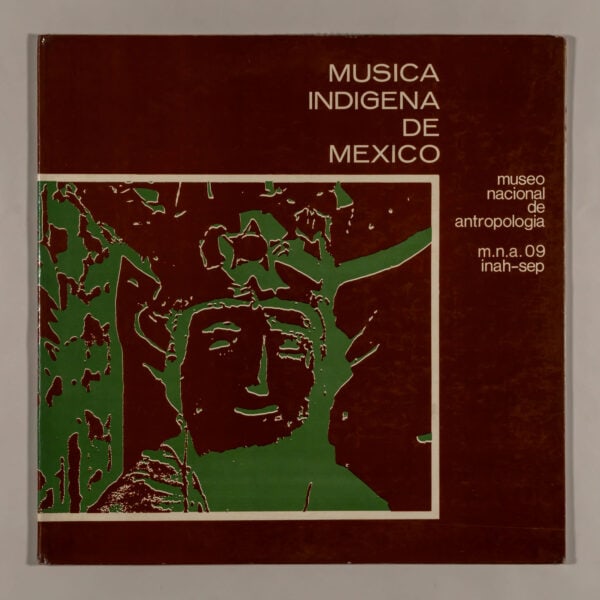







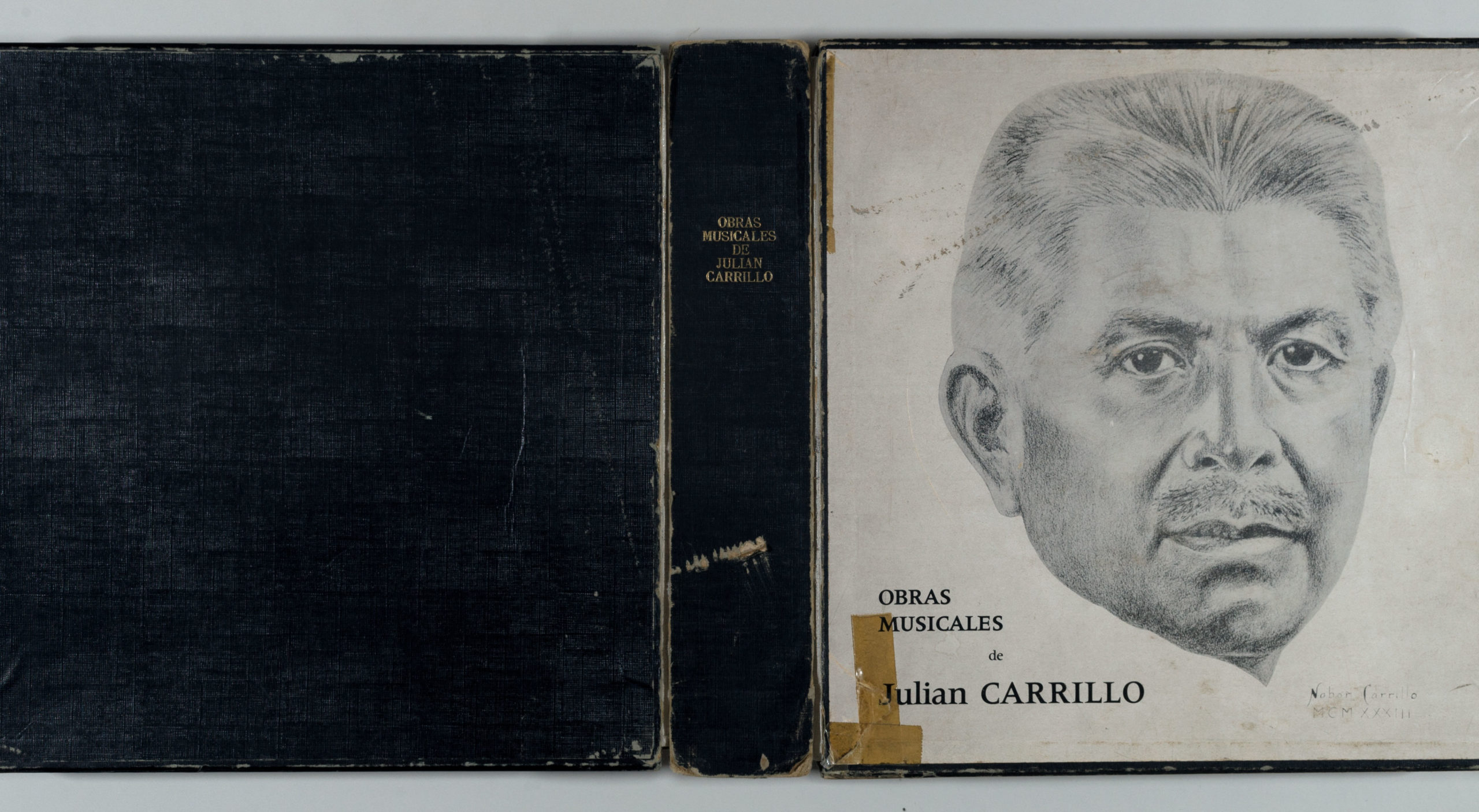


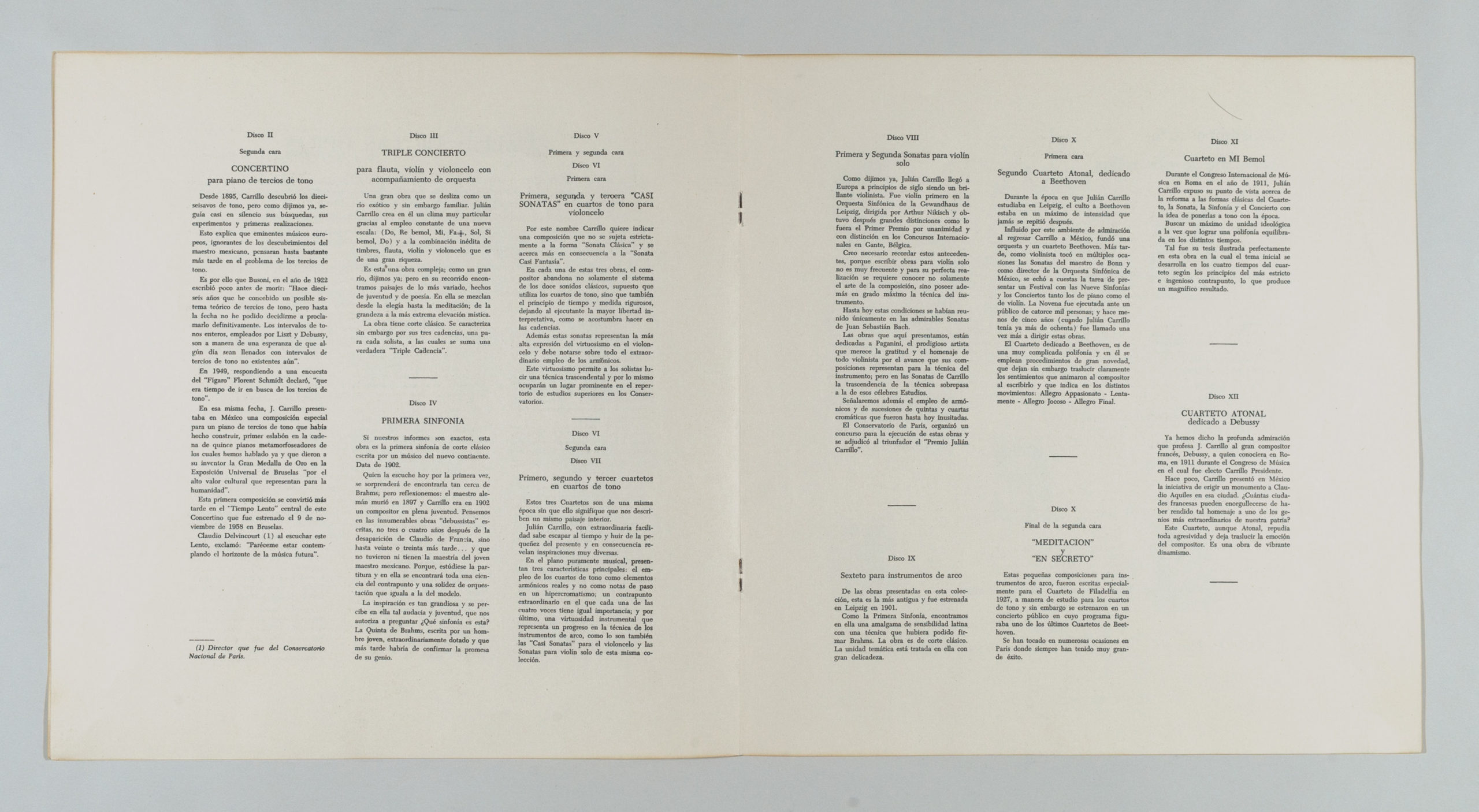








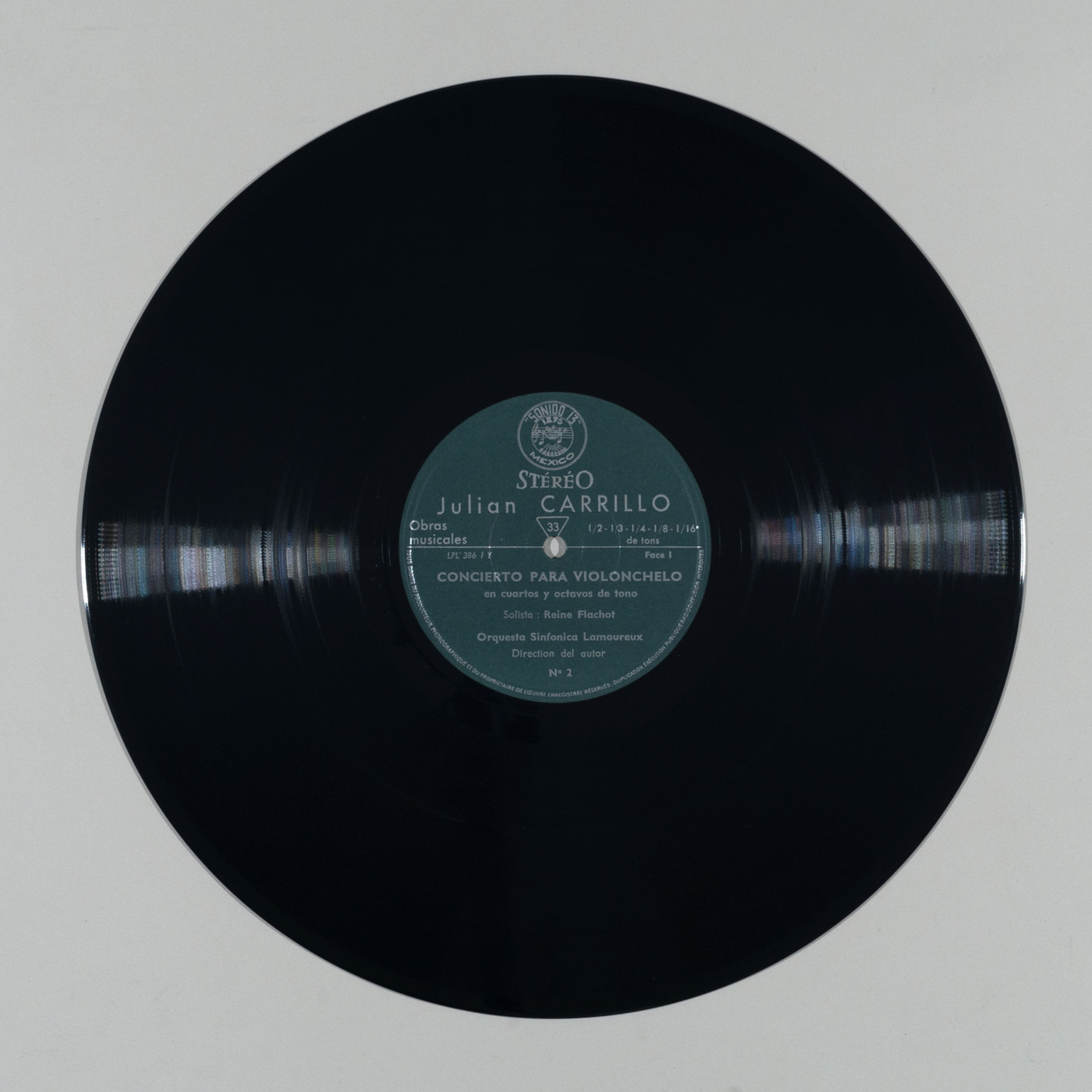


















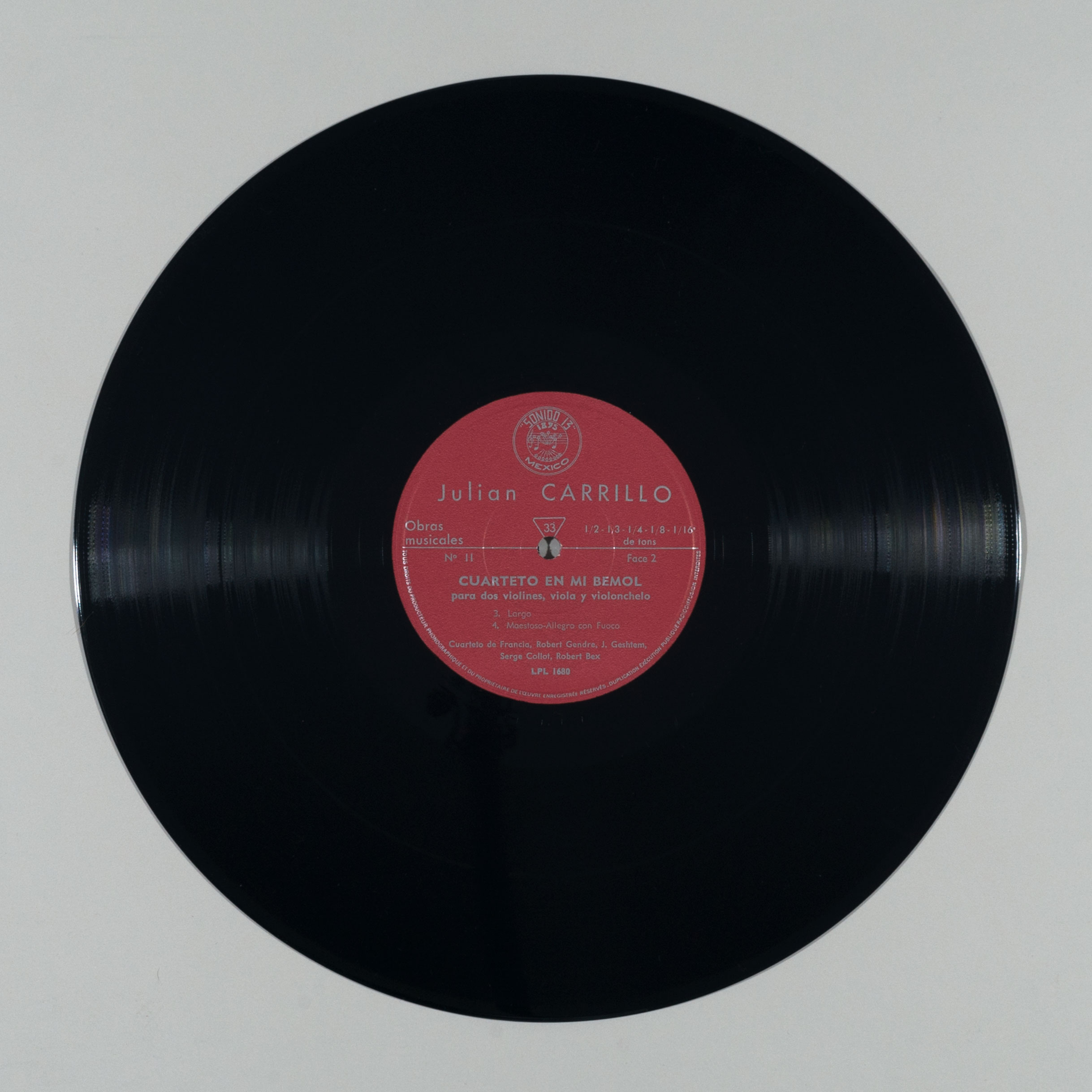


 Julian Carrillo 12" Mexican rare p.s. 1968 obras musicales de... (12 records)
Julian Carrillo 12" Mexican rare p.s. 1968 obras musicales de... (12 records)